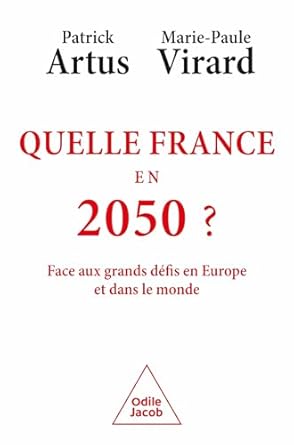The authors have maintained their editorial commitment to presenting facts, studies and commentary without “complacency”! “Pessimism is mood; optimism is will”; here, pessimism is intelligence and unfortunately convincing, optimism is necessity, otherwise the sustainability of our economic and social models is not assured!
Faced with the threat of downgrading, will France and Europe be able to keep up with the American, Chinese or Indian economies? Without divulging the conclusion, the book offers a few keys to ensure that we don’t fall too far behind on the Kantian theme: what are we allowed to hope for?
For the French, it’s a question of taking up six major challenges: demographic ageing, the fragmentation of the world, the energy transition (and not the ecological transition…), the battle of savings, not forgetting the upheavals associated with the transition from an economy of abundance to one of scarcity.
Ageing is on the rise, and is associated with a decline in productivity gains, a structural increase in inflation, and a lasting imbalance in public finances. The challenge is therefore to prevent ageing from weighing too heavily on long-term growth, and hence on people’s standard of living.
The fragmentation of the world is leading to a more expensive and less efficient economy, which will primarily affect emerging countries; France and other developed countries should adapt to this new situation by maintaining sufficient interdependence.
To maintain its industrial base in 2050, Europe, and France in particular, will have to complete its cultural transformation and mobilize national and mutualized financial resources, and above all private savings, either voluntarily or “forced” (compulsory borrowing and/or taxation).
To mobilize long-term savings, it will be necessary to avoid public deficits aimed at stimulating consumption, to avoid shortening the average maturity of financial assets, to avoid reducing the degree of risk on these assets, to avoid encouraging the use of savings for consumption, and to favor, through economic policy, any measure favorable to increasing incomes and therefore available savings. These recommendations should lead to a different sharing of value from that experienced since the 1980s.
Similarly, for the energy transition to take place as smoothly as possible, “we need to move away from the neo-liberal model, and get companies and their shareholders to accept a relative reduction in the return on their equity”. “All economic agents are going to have to adjust their priorities and behavior”, as “the transition promises to be difficult for everyone”. Decision-makers must make an effort to convince the public that inaction will have an economic and, above all, a social cost that justifies efforts now and massive investment to found a new, solid and fairer growth model; thus rejecting any growth model that leads to the mortal attrition of the most fragile economic agents.
The last two chapters of the book are devoted to the future of France and the eurozone: how to escape the trap of weak growth, and how to devise an economic, monetary (the ECB) and budgetary policy capable of changing the situation?
In terms of growth, we need to increase the number of hours worked by the entire population (122 hours less than the European average), by increasing the working week (but only one hour behind Germany) and reducing the number of work stoppages (twice as high in France as in Germany). Then, we need to increase the employment rate through training and incentives; since we’re dealing with poorly trained people, the economy’s productivity gains will be delayed. Finally, technological innovation will require substantial investment, which can be financed by the zone’s savings, provided these do not go to the United States and can circulate smoothly between the countries in the zone.
Last but not least: the Commission’s economic policy and the ECB’s monetary policy. The solutions put forward are “disruptive”, to borrow a term from the authors. Better “a disruptive policy than a dead one”!
The “classic” criteria are obsolete, as they still fail to differentiate between operating and capital expenditure, and do not sufficiently take into account the notion of cycles, contrary to the decisions taken during the COVID crisis. The authors even consider that such tightening would lead to Europe’s definitive stalling. What is needed, therefore, is flexibility guided by clear industrial strategies, and a renewal of Community loans.
As for monetary policy, “it is ineffective”. At the time of writing, the authors considered that the fall in inflation was the result of a drop in energy and raw material prices, but that inflation remained at around 3.5%, a level that would be reached again in 2025. This summer, it has to be said that this forecast has not been borne out. But see….
In any case, the authors question the 2% “dogma”, considering that the target should be closer to the “natural rate” and vary according to economic cycles (Friedman versus Hayek!). Certainly, to get out of the current and future slump, we need to recreate a negative real interest curve, enabling us, among other things, to maintain or even increase deficits without increasing debt; to “rewrite a few articles of the Maastricht Treaty”; to pursue an “expansionary monetary policy” and, finally, to promote the establishment of a complete “Banking Union” and “Savings and Investment Union”.
It’s interesting to note that the economic proposals on wealth creation, mobilizing savings and financing investment in France are to be found in the “Bayrou plan” of summer 2025 (which lacks an element on pensions for well-known political reasons), and that the monetary guidelines are being taken by the government to Brussels and Frankfurt. But, as we can see, the priorities needed in France are not necessarily acceptable in Germany, the Netherlands or Italy.
Like its predecessors, this well-documented book is a useful contribution to the debate; it is even “in tune with the times”, which is not often the case in a complicated subject. All that remains is for politicians to identify the possible paths. “Somebody would have said: ”What a task!
Column written by Dominique Chesneau


